Importance of Mirrors in Bathroom Design
Mirrors play a crucial role in any bathroom design, serving both practical and decorative purposes. They are not just for checking your appearance; they can also make a small bathroom feel larger and more open by reflecting light and creating the illusion of space. A well-chosen mirror can act as a focal point, adding character and enhancing the overall style of the room. Whether your bathroom is modern, traditional, or somewhere in between, the right mirror can tie the whole look together, making the space more cohesive and visually appealing.
Purpose of the Post
The purpose of this post is to guide you in selecting and placing the perfect mirror for your bathroom. With so many options available, choosing the right mirror can seem overwhelming. This post will help you understand the different types of bathroom mirrors, the materials they’re made from, and the design styles they complement. Additionally, it will offer practical tips on choosing the right size and placing your mirror for maximum impact. Whether you're renovating your bathroom or just looking to refresh its look, this guide will provide you with the information you need to make an informed decision. The right mirror can transform your bathroom, enhancing both its functionality and its aesthetic appeal. By the end of this post, you'll have a clear idea of how to select a mirror that not only suits your personal style but also elevates the overall design of your bathroom.
Types of Bathroom Mirrors
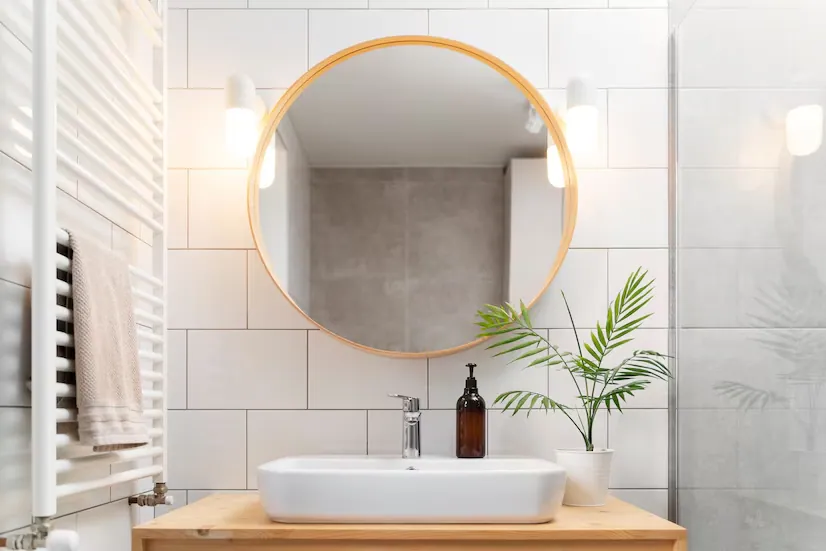
Framed vs. Frameless Mirrors
When choosing a bathroom mirror, one of the first decisions to make is whether you prefer a framed or frameless design. Framed mirrors come with a border made from materials like wood, metal, or plastic, which can add a decorative element to your bathroom. The frame can be simple or ornate, depending on your style preference, and can help tie the mirror into the overall design of the space. On the other hand, frameless mirrors offer a clean, sleek look that is often associated with modern or minimalist bathrooms. Without a frame, these mirrors create a seamless appearance, making them a good choice for smaller bathrooms where you want to keep the design simple and uncluttered.
Round Mirrors
Round mirrors are a popular choice for adding a soft, modern touch to your bathroom. Their circular shape contrasts nicely with the typically straight lines of bathroom fixtures and tiles, creating an eye-catching focal point. Round mirrors are often used in contemporary or transitional bathroom designs, where their smooth curves can help balance the harder edges of other elements in the room. Additionally, the absence of sharp corners in round mirrors can make the space feel more inviting and harmonious.
Rectangular Mirrors
Rectangular mirrors are the most common and versatile type of bathroom mirror. They fit well in almost any design style, from traditional to modern. Their straight edges and large surface area make them practical for daily use, providing a clear, unobstructed view. Rectangular mirrors can be hung vertically or horizontally, depending on the look you want to achieve and the space available.
Lighted Mirrors
Lighted mirrors come with built-in lighting, which not only enhances their functionality but also adds ambiance to the bathroom. The integrated lights provide even illumination, making tasks like shaving or applying makeup easier. Additionally, lighted mirrors can serve as a decorative feature, contributing to the overall atmosphere of the bathroom by creating a warm, inviting glow.
Material Options
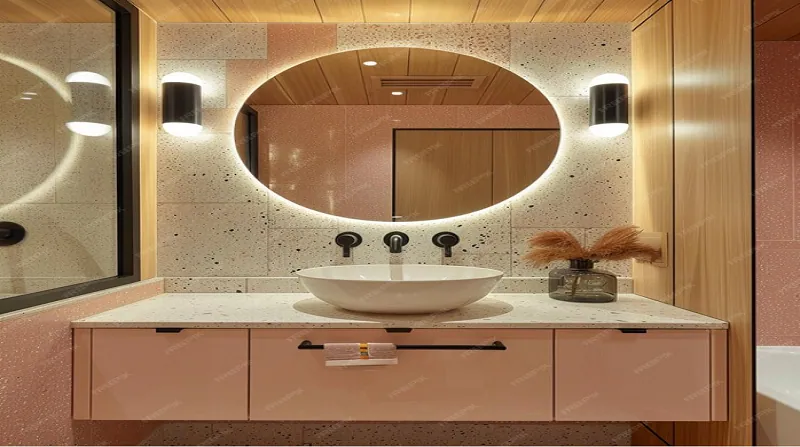
When selecting a bathroom mirror, the materials used play a crucial role in both the mirror’s appearance and its durability. Understanding these material options can help you choose a mirror that not only enhances your bathroom's aesthetics but also stands the test of time.
Glass Quality
One of the most important factors in a bathroom mirror is the quality of the glass. High-quality glass ensures that the reflection is clear and distortion-free, which is essential for tasks like grooming. A well-made glass mirror will have a smooth, even surface that reflects light accurately, without any warping or imperfections. Additionally, high-quality glass is more resistant to scratches and other types of damage, ensuring that the mirror remains looking new for longer. When choosing a mirror, it’s worth investing in one made from premium glass to guarantee both clarity and longevity.
Frame Materials
The material of the frame, if you opt for a framed mirror, significantly influences the mirror's durability and style. Wood frames are a classic choice that brings warmth and natural beauty to the bathroom. They are available in a range of finishes, from natural wood tones to painted colors, making them versatile for various design styles. However, wood frames need to be properly sealed to withstand the moisture and humidity typically found in bathrooms.
Metal frames offer a sleek and modern look, often associated with contemporary or industrial design styles. Metals like stainless steel, brass, or aluminum are popular for their durability and resistance to rust and corrosion. These frames add a touch of elegance and can be polished for a shiny finish or brushed for a more subdued appearance.
Plastic frames are an affordable and lightweight option. They come in a variety of colors and finishes, mimicking the look of wood or metal. While plastic frames are easy to maintain and won’t rust, they may not offer the same level of durability as wood or metal frames.
Choosing the right materials for your bathroom mirror ensures that it complements your bathroom’s design while remaining functional and long-lasting.
Design and Style Considerations
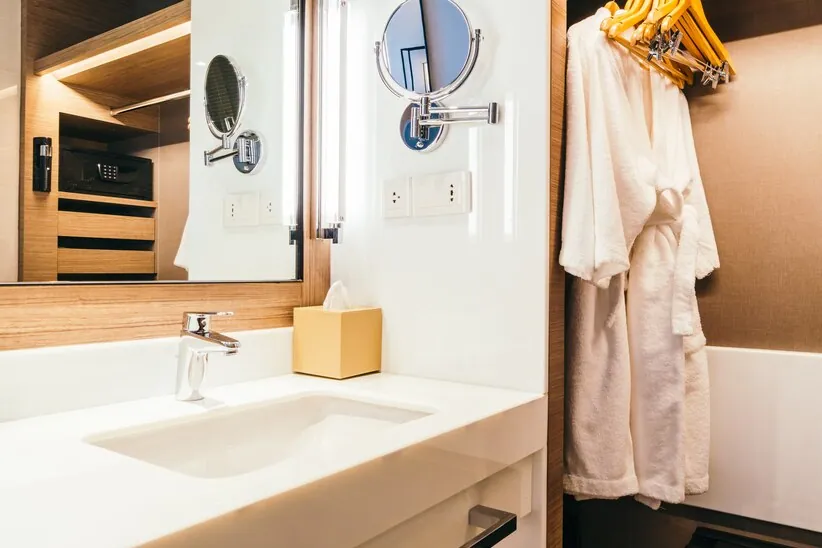
When choosing a bathroom mirror, design and style are essential factors that influence the overall look and feel of your bathroom. Here’s how different design styles can enhance your space:
Traditional Designs
Traditional bathroom mirrors often feature classic frames with ornate details, such as intricate carvings or decorative moldings. These mirrors are perfect for creating a timeless and elegant atmosphere in your bathroom. Traditional designs typically use rich materials like wood or brass, adding a sense of warmth and luxury. If your bathroom has a more classic décor with vintage fixtures or traditional cabinetry, a traditional mirror can complement these elements beautifully, bringing a cohesive and sophisticated look to the space.
Modern Designs
For those who prefer a more contemporary look, modern mirrors are an excellent choice. These designs are characterized by sleek and minimalistic frames, often made of metal or frameless altogether. The simplicity of modern mirrors makes them versatile and suitable for various bathroom styles. They are especially effective in smaller bathrooms, where their clean lines and lack of ornamentation help create a sense of openness and simplicity. Modern designs often incorporate innovative features like LED lighting or anti-fog technology, adding to their functionality.
Rustic Designs
Rustic mirrors are ideal for creating a cozy and inviting bathroom. These mirrors often feature natural textures and earthy tones, such as reclaimed wood frames or distressed finishes. Rustic designs bring a touch of nature into your bathroom, making the space feel warm and welcoming. These mirrors pair well with other natural elements like stone countertops, wooden cabinetry, or earthy color palettes, making them a great fit for bathrooms with a farmhouse or cottage-inspired design.
Transitional Designs
If you enjoy elements of both traditional and modern styles, transitional mirrors offer the best of both worlds. Transitional designs blend classic and contemporary features, creating a balanced and versatile look. These mirrors might have a traditional shape with modern materials or a minimalist design with subtle, ornate details. Transitional mirrors are a great choice for those who want a timeless look that remains adaptable to changing design trends.
Choosing the right design and style for your bathroom mirror can transform your space, enhancing both its aesthetics and functionality.
Size and Placement Considerations
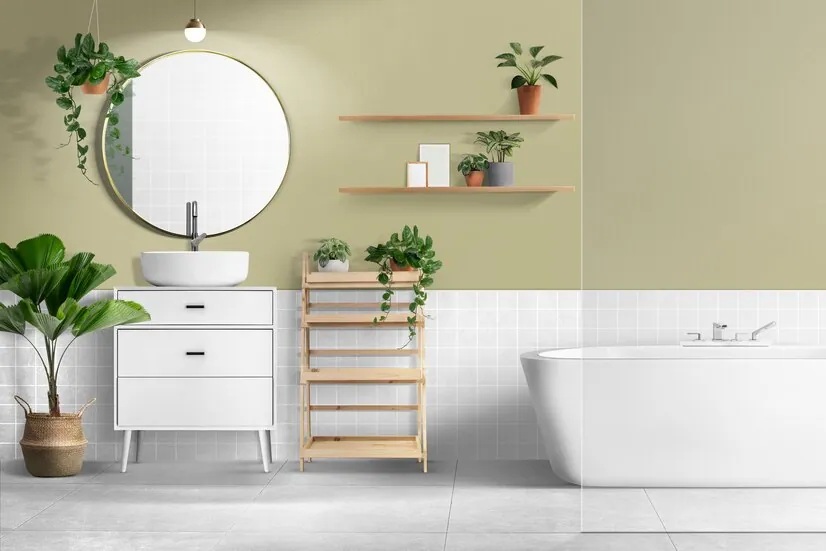
Selecting the right size and placement for your bathroom mirror is crucial to ensuring it fits well in the space and enhances both the room’s aesthetics and functionality. Here’s how to approach these important factors:
Choosing the Right Size
When choosing the size of your bathroom mirror, it’s essential to consider the scale of the room and the vanity. The mirror should be proportional to the vanity; a general rule of thumb is to choose a mirror that is slightly narrower than the vanity or sink. This creates a balanced look and ensures that the mirror doesn’t overwhelm the space.
For smaller bathrooms, a larger mirror can create the illusion of more space by reflecting more light and making the room feel bigger. However, make sure the mirror doesn’t extend beyond the edges of the vanity or interfere with other elements like lighting fixtures. In larger bathrooms, you have more flexibility and can opt for wider or taller mirrors, depending on the style you’re aiming for. If your vanity is particularly wide, consider using multiple mirrors or a mirror that spans the entire width of the vanity for a grander effect.
Optimal Placement
The placement of your bathroom mirror is just as important as its size. The most common and functional position is directly above the vanity or sink, where it is easily accessible for daily grooming tasks. When positioning the mirror, ensure that it is centered above the faucet and at a height that allows all users to see themselves comfortably. The bottom edge of the mirror should typically be a few inches above the sink to avoid water splashes, while the top edge should be at least a few inches above the tallest user’s eye level.
In addition to the primary mirror, consider placing additional mirrors on other walls to enhance the room’s visual appeal and brightness. For example, a mirror opposite a window can reflect natural light and make the bathroom feel more open and airy. In bathrooms with interesting architectural features or beautiful tile work, strategically placed mirrors can highlight these elements, adding depth and character to the space.
By carefully choosing the right size and placement for your bathroom mirror, you can significantly enhance both the functionality and style of your bathroom.
Budget Considerations
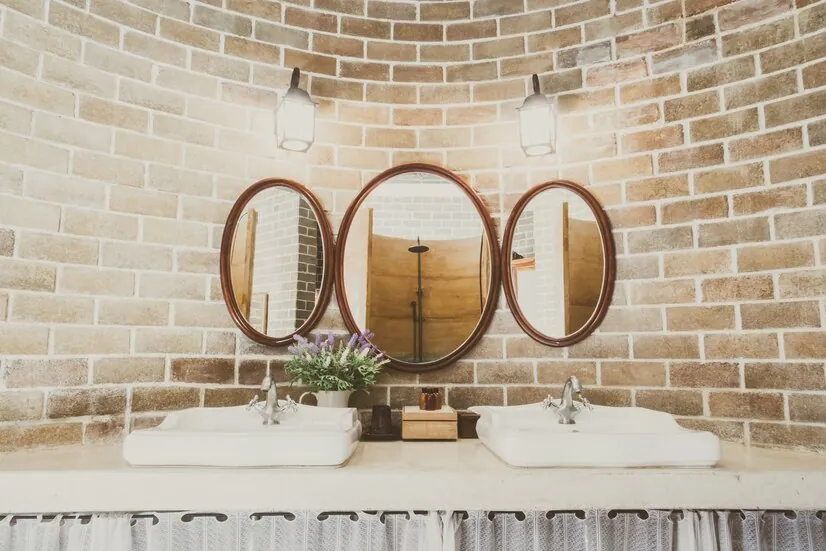
When selecting a bathroom mirror, budget considerations are important to ensure that you get the best value without overspending. Here are some key points to keep in mind when setting a budget and understanding the cost versus value of your purchase.
Setting a Budget
Before you start shopping for a bathroom mirror, it’s important to set a budget. This helps you narrow down your options and avoid spending more than you planned. Consider how much you’re willing to invest in a mirror based on your bathroom renovation or decoration budget. Mirrors come in a wide range of prices, depending on factors like size, material, brand, and special features such as built-in lighting or anti-fog technology.
Balancing cost with quality and style is essential. While it might be tempting to go for the cheapest option, keep in mind that lower-priced mirrors may not have the durability or aesthetic appeal you’re looking for. On the other hand, very expensive mirrors might offer luxurious features but could stretch your budget too thin. Aim to find a mirror that meets your needs in terms of size, design, and functionality, while also fitting within your budget.
Cost vs. Value
When considering the cost of a mirror, think about the long-term value it will bring to your bathroom. A well-chosen mirror can significantly enhance the overall look and feel of your space, making it feel more spacious, bright, and stylish. Investing in a mirror that complements your bathroom’s design and serves your functional needs can be a wise decision, as it will likely contribute to your bathroom’s aesthetic for many years.
Additionally, high-quality mirrors made from durable materials may cost more upfront but can save you money in the long run by lasting longer and requiring less maintenance. Features like built-in lighting or fog-resistant coatings may add to the initial cost but can improve the mirror’s usability and your daily bathroom experience.
In conclusion, setting a realistic budget and considering the long-term value of your bathroom mirror will help you make a smart investment that enhances both the style and functionality of your bathroom.
Maintenance Tips
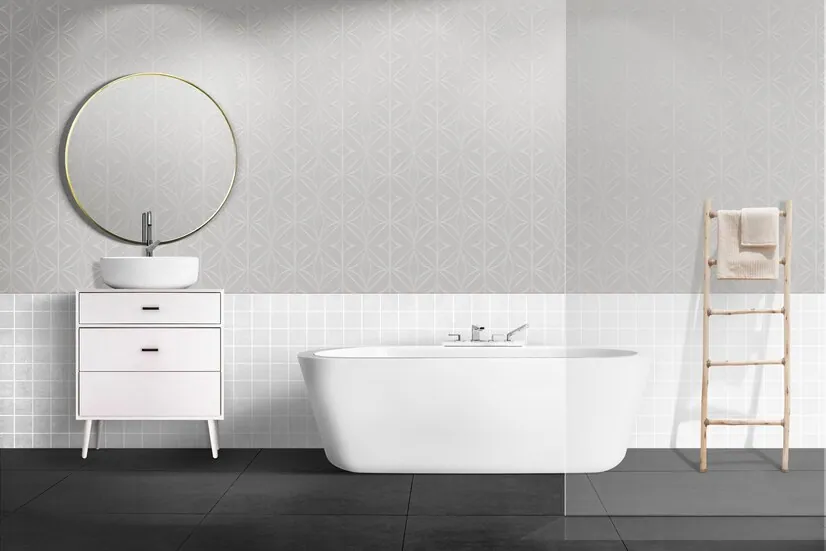
Proper maintenance of your bathroom mirror ensures it stays clean, clear, and in good condition for years. Here are some simple tips for routine cleaning and frame care.
Routine Cleaning
To keep your bathroom mirror spotless and free of streaks, regular cleaning is essential. Start by using a soft, lint-free cloth or a microfiber cloth, as these are gentle on the glass and help avoid scratches. For the cleaning solution, you can use a mixture of equal parts water and white vinegar or a glass cleaner. Spray the solution onto the cloth (not directly on the mirror) and gently wipe the surface in circular motions.
After wiping down the mirror, use a dry section of the cloth to buff away any remaining moisture, ensuring a streak-free finish. Avoid using abrasive cleaners or rough sponges, as these can scratch the glass and damage the reflective coating.
For mirrors with built-in lighting, take extra care not to let moisture seep into the electrical components. Gently clean around the lights with a dry cloth.
Frame Care
The frame of your mirror also needs attention, and the care required will depend on the material of the frame. Here are some tips based on common materials:
- Wood Frames: Wood frames should be dusted regularly with a dry or slightly damp cloth. Avoid using harsh chemicals or excessive water, as these can damage the wood finish. If the wood appears dull, you can apply a small amount of furniture polish to restore its shine.
- Metal Frames: Metal frames can be cleaned with a soft cloth and a mild detergent mixed with water. Be sure to dry the frame thoroughly to prevent water spots or rust, especially if the metal is not stainless steel.
- Plastic Frames: Plastic frames are generally low-maintenance and can be wiped down with a damp cloth and mild soap. Avoid using abrasive cleaners that could scratch the plastic surface.
- Glass Frames: If your mirror has a glass frame, clean it as you would the mirror itself, using a soft cloth and a gentle glass cleaner.
Regular maintenance of both the mirror surface and the frame will keep your bathroom mirror looking its best and prolong its lifespan.
Recap of Key Points
Choosing the right bathroom mirror involves several key considerations. First, think about the type of mirror—framed, frameless, round, or lighted—each offering different styles and functions. Consider the quality of the glass and the material of the frame for durability and aesthetics. Match the mirror’s design with your bathroom’s style, and ensure its size and placement enhance both functionality and appearance. Finally, balance your budget with the mirror’s quality and style.
Encouragement to Explore Options
Explore various mirror options to find one that perfectly complements your bathroom. A well-chosen mirror can significantly enhance the space’s look and functionality. Enjoy selecting a mirror that reflects your personal style and meets your needs!
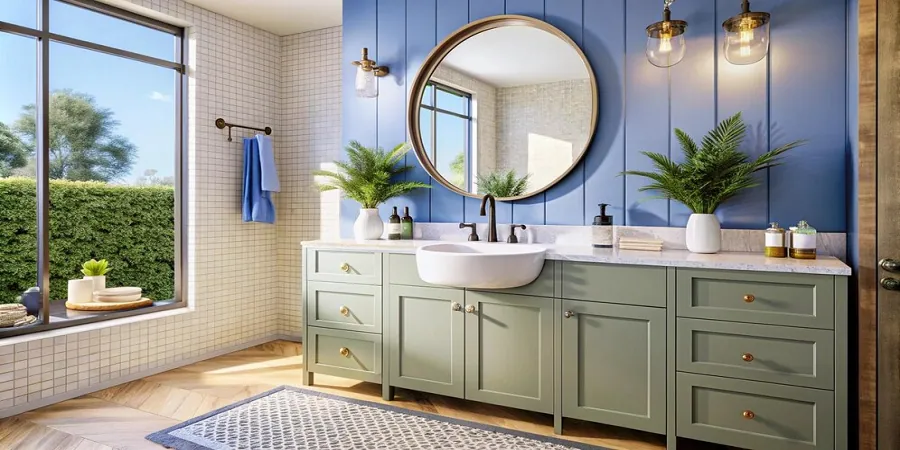
Comments